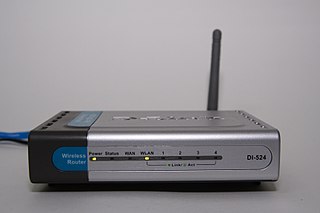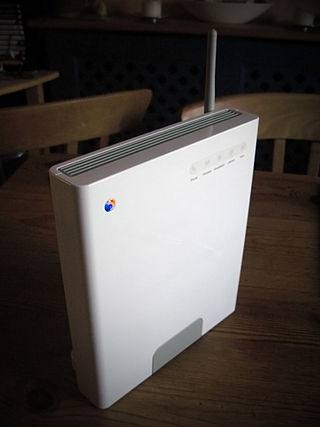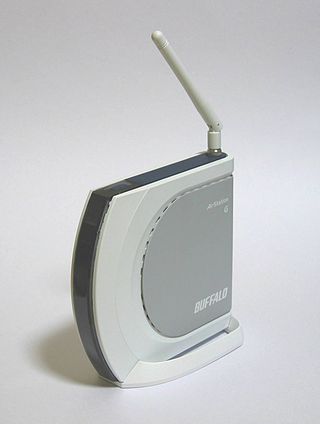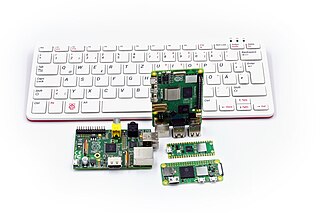
AirPort is a discontinued line of wireless routers and network cards developed by Apple Inc. using Wi-Fi protocols. In Japan, the line of products was marketed under the brand AirMac due to previous registration by I-O Data.

AirPort Extreme is a line of residential gateways made by Apple Inc. that combine the functions of a router, network switch, wireless access point and NAS as well as varied other functions. It is one of Apple's former AirPort products. The latest model, the 6th generation, supports 802.11ac networking in addition to older standards. Versions of the same system with a built-in network-accessible hard drive are known as the AirPort Time Capsule.
A wireless distribution system (WDS) is a system enabling the wireless interconnection of access points in an IEEE 802.11 network. It allows a wireless network to be expanded using multiple access points without the traditional requirement for a wired backbone to link them. The notable advantage of WDS over other solutions is that it preserves the MAC addresses of client frames across links between access points.

The Linksys WRT54G Wi-Fi series is a series of Wi-Fi–capable residential gateways marketed by Linksys, a subsidiary of Cisco, from 2003 until acquired by Belkin in 2013. A residential gateway connects a local area network to a wide area network.

A wireless router or Wi-Fi router is a device that performs the functions of a router and also includes the functions of a wireless access point. It is used to provide access to the Internet or a private computer network. Depending on the manufacturer and model, it can function in a wired local area network, in a wireless-only LAN, or in a mixed wired and wireless network.

DD-WRT is Linux-based firmware for wireless routers and access points. Originally designed for the Linksys WRT54G series, it now runs on a wide variety of models. DD-WRT is one of a handful of third-party firmware projects designed to replace manufacturer's original firmware with custom firmware offering additional features or functionality.
The DG834 series are popular ADSL modem router products from Netgear. The devices can be directly connected to a phone line and establish an ADSL broadband Internet connection to an internet service provider (ISP) and share it among several computers via 802.3 Ethernet and 802.11b/g wireless data links.

Tomato is a family of community-developed, custom firmware for consumer-grade computer networking routers and gateways powered by Broadcom chipsets. The firmware has been continually forked and modded by multiple individuals and organizations, with the most up-to-date fork provided by the FreshTomato project.

The BT Smart Hub is a family of wireless residential gateway router modems distributed by BT for use with their own products and services and those of wholesale resellers but not with other Internet services. Since v 5, Home/Smart Hubs support the faster Wi-Fi 802.11ac standard, in addition to the 802.11b/g/n standards. All models of the Home Hub prior to Home Hub 3 support VoIP Internet telephony via BT's Broadband Talk service, and are compatible with DECT telephone handsets. Since the Home Hub 4, all models have been dual band.

Buffalo AirStation is the name given to a series of wireless LAN equipment sold by Buffalo Technology.

The Texas Instruments AR7 or TI-AR7 is a fully integrated single-chip ADSL CPE access router solution. The AR7 combines a MIPS32 processor, a DSP-based digital transceiver, and an ADSL analog front end.

The AirPort Time Capsule is a wireless router which was sold by Apple Inc., featuring network-attached storage (NAS) and a residential gateway router, and is one of Apple's AirPort products. It is essentially a version of the AirPort Extreme with an internal hard drive. Apple describes it as a "Backup Appliance", designed to work in tandem with the Time Machine backup software utility introduced in Mac OS X 10.5.
The WGR614L is an 802.11b/g wireless network router created by Netgear. It was officially launched on June 30, 2008. The WGR614L runs an open source linux firmware and supports the installation of third party packages such as DD-WRT, Tomato, and OpenWrt.
Linksys manufactures a series of network routers. Many models are shipped with Linux-based firmware and can run third-party firmware. The first model to support third-party firmware was the very popular Linksys WRT54G series.
Common Firmware Environment (CFE), sometimes pronounced as 'cafe', is a firmware interface and bootloader developed by Broadcom for 32-bit and 64-bit system-on-a-chip systems. It is intended to be a flexible toolkit of CPU initialization and bootstrap code for use on embedded processors. It is roughly analogous to the BIOS on the IBM PC platform. Its source code is available as open source from Broadcom. Common embedded system alternatives include Das U-Boot.
OpenWrt is an open-source project for embedded operating systems based on Linux, primarily used on embedded devices to route network traffic. The main components are Linux, util-linux, musl, and BusyBox. All components have been optimized to be small enough to fit into the limited storage and memory available in home routers.

Raspberry Pi is a series of small single-board computers (SBCs) developed in the United Kingdom. The original Raspberry Pi computer was developed by the Raspberry Pi Foundation in association with Broadcom. Since 2012, all Raspberry Pi products have been developed by Raspberry Pi Ltd, which began as a wholly-owned subsidiary of the Foundation.

Banana Pi is a line of single-board computers produced by the Chinese company Shenzhen SINOVOIP Company, its spin-off Guangdong BiPai Technology Company, and supported by Hon Hai Technology (Foxconn). Its hardware design was influenced by the Raspberry Pi, and both lines use the same 40-pin I/O connector.













